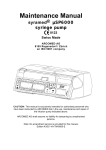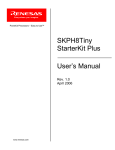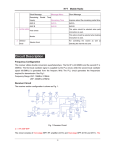Download Renesas H8/36912 User manual
Transcript
SKP36912G USER MANUAL FOR H8/36912F ON-CHIP FLASH MICROCONTROLLER TABLE OF CONTENTS 1.0 INTRODUCTION....................................................................................................2 2.0 KIT CONTENTS......................................................................................................3 2.1 36912G Starter Kit Plus (SKP) Product List.............................. ...................……..3 3.0 SYSTEM REQUIREMENT.....................................................................................3 3.1 Host Computer Requirements................................................................................3 3.2 SKP36912G Board................................................................................................3 3.3 Development Tools...............................................................................................4 3.4 Power Supply........................................................................................................4 3.5 Software Tools…………………….…………………………………………….…….4 4.0 HARDWARE..................................................................................................…......5 4.1 SKP36912G Board.................................................................................…….........5 5.0 SPECIFICATIONS............................................................................……………...5 5.1 General...............................................................................................………….5 5.2 RS-232 Communications.....................................................................………...5 5.3 I2C Communications...............................................................................….…...5 5.4 Power..............................................................................................…………….6 5.5 Low Voltage Detection........................................................................................6 6.0 SKP Functional Blocks............................................................................………......6 7.0 PRINCIPLES OF OPERATION......................................................……………….7 7.1 H8/36912F Microcontroller……….............................................……………...7 7.2 External Low Voltage Detection…………….............................……………….7 7.3 CLOCK CIRCUITRY..........................................................………………….7 7.4 RESET CIRCUITRY..........................................................…………………..8 7.5 NMI CIRCUITRY..........................................................……………………..8 7.6 I2C INTERFACING..........................................................…………………...8 7.7 RAM AND FLASH ROM..........................................................……………...8 7.8 SERIAL INTERFACE..........................................................…………………8 7.9 LEDS and DIP Switches..........................................................………………..8 7.10 EXTERNAL USER INTERFACE.........................................................……..10 8.0 DIP SWITCH & JUMPERS..........................................................………………....10 9.0 APPENDIX..........................................................…………… ........………………12 9.1 BOARD LAYOUT….......................................................…………………12 9.2 EDGE CONNECTOR CN2 PIN OUT................................……………….13 9.3 H8/36912F MEMORY MAP...............................................………..……...14 9.4 SKP36912G SCHEMATICS...............................................……………….15 1 1.0 INTRODUCTION The H8/36912F Starter Kit Plus (SKP) is a compact system to evaluate MCU performance for the Renesas H8/300H µTINY family of micro controllers. The kit also includes sample code, documentation and tutorial to jumpstart development. It incorporates a programming system for the H8/36912F on-chip FLASH device. It contains a SOP-32 package H8/36912F microcomputer on the board. The H8/36912F SKP board adopts the common Hitachi Embedded Workshop (HEW) version 3.0 that also contains a pure debugger as the user interface. The diagram below shows the H8/36912F SKP Board: SKP36912G EVALUATION BOARD The diagram below shows the physical layout of the SKP: - 2 2.0 Kit Contents This section describes the contents of the 36912G Starter Kit Plus (SKP) product package. When unpacking your kit, please check to see that all products listed below are included. 2.1 36912G Starter Kit Plus (SKP) Product List Table 2-1 lists the products included in the kit. Table 2-1 SKP36912G Product List Product Name Qty Remark Remark Product Name SKP36912G Board DC jack Male 12mm PCB Spacers CD-ROM 3.0 Qty 1 1 4 1 H8/36912F Target Board Jack to connect to power supply PCB spacers to give balance height for board a) Manuals – Quick Start Guide User Manual Application Notes b) H8/36912F Hardware Manual c) E7 Emulator User manual d) E7 Emulator connectivity for H8/36912F manual e) HEW 3.0 User manual f) Sample Programs g) SKP36912G schematic diagram System Requirement The following lists the hardware and software products required for using the SKP36912G. • • • • • Host Computer with available USB port SKP36912G Board E7 Emulator DC Power Supply of 5V ~ 12V Software Tools (HEW 3.0) 3.1 Host Computer Requirements The minimum requirement to be able to use the software that comes with the kit is a PC with an available USB port and Microsoft Windows 98, ME, 2000, or XP operating system. 3.2 SKP36912G Board The SKP36912G board provides a compact evaluation and development environment for the H8/36912F micro controller. It has four switches (pushbutton and DIP), LED’s for user interface and a 2-pin jumper for current measurement. 3 It also has a low drop out regulator, which regulates up to 12V DC input voltage and gives 5V output and is capable of supplying output currents up to 300mA, 24C02 EEPROM for RAM backup at low voltage detection and MAX232 for serial communication. 3.3 Development Tools E7 Emulator is used as a development tool to execute and debug the user programs on the SKP. The diagram below shows how to connect the SKP to a PC using E7 Emulator. Please see the quick start guide on how to run the SKP using E7 Emulator. System Configuration with Emulator 3.4 Power Supply The SKP hardware requires a power supply of +5V DC. Since total power consumption can vary widely due to external connections, a micro power Low Drop out Voltage Regulator (LDO) is used with a maximum current rating of 300mA at 5V DC power supply. 3.5 Software Tools The High-performance Embedded Workshop (HEW) provides an Integrated Development Environment (IDE) and Graphical User Interface (GUI) that integrates the software development tools and provides project management features. 4 4.0 Hardware 4.1 SKP36912G Board Figure 5-1 shows the 36912G Board with major components identified. E7 Connector 20K POT SW2 MAX232 74HC00 JP1 for current measurement Serial port Female Connector CN2 pin 4, 6 Low Drop out Regulator H8/36912 SW1 Reset Switch SW3 24C02 EEPROM SW4 DC Jack to input DC +5V supply 9.8304MHz crystal LEDs SKP36912G Board 5.0 SPECIFICATIONS 5.1 GENERAL • H8/36912F micro controller (using HD64F36912G SOP32 device). • 8Kbytes of FLASH • 1536 bytes of internal RAM • Four user LED indicators. • BOOT mode Led indicator and a Reset mode Led indicator. • DIP switch to control BOOT mode and a push button switch to control reset. • DIP switch to control Port 8 I/O pins as I/O or led indicators. • DIP switch to check oscillator break function of micon. • DIP switch to control TxD and RxD led indication. 5.2 RS-232 COMMUNICATIONS • SCI3 interface via RS-232 DB-9S connector and MAX232 chip. 5.3 I2C COMMUNICATION • A 2KBit ST24C02 EEPROM is used to store data when Low voltage is detected. 5 5.4 POWER • 5V DC power supply. 5.5 LOW VOLTAGE DETECTION • A 20K Pot P1 along with ladder network resistors is used to generate required voltages for External Low Voltage Detection. 6.0 SKP FUNCTIONAL BLOCKS The SKP is composed of a H8/36912F single-chip micro-controller, Low Voltage Drop Out Regulator, 2KBit EEPROM, Serial port, 20K POT for LVD & ADC, Dipswitches for Oscillator break & Boot/User mode transition, user interface LEDs and E7 Header to connect with E7 Emulator. JP1 jumper is used for current measurement of the micon. This jumper is always closed and opened during current measurement. The DIP Switch SW1 is used to select the programming mode for the micon i.e., Boot mode or User mode for programming the FLASH. A reset switch SW3 is also provided with a reset led indication. SCI3 is used to program the board’s on-chip flash memory using FDT or it is used for Serial transmission or reception. 6 The DIP Switch SW2 is used to select led indication on OSCBK/PWM1 and LVD/PWM2 LEDs. The DIP Switch SW4 is used to connect or disconnect led indication on TxD and RxD LEDs during serial communication. Low Voltage Detection is detected using Pot P1 and resistor ladder network. A 2Kbit EEPROM is used to store data during low voltage detection and recover data stored when micon operates at normal voltage. A/D conversion is also carried using the same POT P1. Analog signal is supplied to the microcontroller by varying POT and digital output is checked on internal registers. 7.0 PRINCIPLES OF OPERATION The SKP is composed of the following components: • • • • • • • • • H8/36912F micro controller External Low Voltage Detection circuitry Clock circuitry RESET circuitry NMI circuitry I2C Interface Serial Interface (SCI3) LED driver External User Interface 7.1 H8/36912F MICROCONTROLLER The H8/36912F provides many of the functions required to implement a micro-controller system on-chip. It has on-chip 8Kbytes of FLASH and 1536 bytes of RAM. It has additional features of External Low Voltage Detection and Internal RC oscillator backup on external crystal break. 7.2 EXTERNAL LOW VOLTAGE DETECTION The External low voltage detection circuitry comprises of a resistor ladder network. A 20K POT in series with a 1.5K and 3.9K resistors are used to meet the typical voltage levels for LVD detection at 5V operation. 7.3 CLOCK CIRCUITRY The clock circuitry comprises the H8/36912F oscillator and a 9.8304MHz parallel resonating crystal. The system clock output frequency is same as that of internal RC clock. A DIP switch SW1.1 is used to indicate the RC oscillator back up on external crystal break. 7 7.4 RESET CIRCUITRY The reset circuitry is controlled with a Diode 1N4148, a 0.22uF capacitor and a push button switch SW3. 7.5 NMI CIRCUITRY On the SKP a DIP switch SW1.2 is used to control the NMI pin level. For FDT download, SW1 controls the BOOT and USER mode levels. 7.6 I2C INTERFACING A 2KBit ST24C02 EEPROM (U4) is interfaced using I2C protocol. 7.7 RAM AND FLASH ROM The H8/36912F has 8Kbytes of FLASH ROM and 1536 bytes of RAM. 7.8 SERIAL INTERFACE The SKP supports a three-wire serial channel using the on-chip serial communications channel (SCI3) on the H8/36912F. SCI3 is used to FLASH the device using FDT and for serial communication. The SCI3 port provides the transmit and receive signals to the MAX232 transceiver device. Transmit and receive signals from SCI3 are connected via the RS232 transceiver to a 9-way D-type connector (CN3). The MAX232 transceiver device translates RS232 signals to logic levels and vice versa. A DIP switch SW4 is provided to connect/disconnect TxD and RxD indication led’s. 7.9 LEDS and DIP Switches There are four LED’s on the SKP that are available to the user. Led OSCBK / PWM1 can be driven using Port 84 of the H8/36912F and SW2 pin 1. Power = Power of Target board indication. OSCBK/PWM1 LED = Oscillator Break or PWM of Timer W indication. LVD/PWM2 LED = Low voltage Detection or PWM of Timer W indication. TxD LED = Transmit data indication of SCI3. RxD LED = Receive data indication of SCI3. BOOT LED= Boot mode indication. Reset LED = Reset level indication. External oscillator break indication: Keep SW2.1 in OFF condition and write high on P84 to turn ON OSCBK/PWM1. This led can be used to indicate external clock fail or lit according to PWM pulse width on port 8. 8 To disconnect OSCBK/PWM1 led indication, turn ON SW2.2 pin 1(i.e., connect SW2.1 pin to GND). Low Voltage Detection: Turn ON SW2.2 to use LVD/PWM2 led. This led can be used to indicate low voltage detection or lit according to PWM pulse width on port 8. To disconnect LVD/PWM2 led indication, turn ON SW2.1 pin 1(i.e., connect SW2.1 pin to GND). SCI3: Two led’s TxD and RxD are used to indicate transmit and receive operations of SCI3 during serial communication. Provision to connect/disconnect led indication for these I/O lines is provided using a DIP Switch SW4. Turn ON SW4.1 to use RxD led indication. Turn ON SW4.2 to use TxD led indication. Turn OFF the switch to disconnect the Rx and Tx I/O lines led indication. LED Oscbk/PWM1 Oscbk/PWM1 Oscbk/PWM1 Oscbk/PWM1 LVD/PWM 2 LVD/PWM 2 LVD/PWM 2 LVD/PWM 2 SW1.1 Position ON OFF ON OFF SW1.1 Position --------- SW1.2 Position ON OFF BOOT TxD RxD RESET SW2.2 Position OFF OFF ON ON SW2.1 Position OFF OFF ON ON SW4.1 Position --------ON OFF SW4.2 Position ON OFF --------- P84 Value 0 1 0/1 0/1 P83 Value 1 0 1/0 1/0 LED Status OFF ON OFF OFF LED Status ON OFF OFF OFF SOP-32 pin 29 29 29 29 SOP-32 pin 28 28 28 28 LED Status SOP – 32 PIN ON OFF 13 13 LED Status ON OFF ON OFF SOP – 32 PIN 24 24 23 23 SW3 Position LED Status SOP – 32 PIN 0 1 ON OFF 7 7 9 Pin Function P84/FTIOD P84/FTIOD P84/FTIOD P84/FTIOD Pin Function P83/FTIOC P83/FTIOC P83/FTIOC P83/FTIOC PIN FUNCTION NMI NMI PIN FUNCTION TxD TxD RxD RxD PIN FUNCTION RES RES 7.11 EXTERNAL USER INTERFACE The external user interface makes all H8/36912F signals available to the user consistent. The external user interface consists of rows of 12 pin connectors. The diagram indicates which label refers to which row of pins. The external user interface consists of a 26-pin connector. Commonly available 2.54mm (0.100 inch) pitch male headers. Micon I/O pins are connected to CN2 connector so that I/O lines can be accessed with ease. Pin numbering for starting and ending pins are given for easy use. Provision for user to give separate supply to A/D section Avcc pin is provided by pulling this pin on to I/O expander CN2.Avcc PIN 4 is shorted with Vcc PIN 6 via a 2-pin jumper. User can remove the jumper and give separate supply to Avcc pin. Provision for user to measure the current drawn by the micon is provided using jumper JP1. This jumper is opened when user wants to measure the current. An ammeter is used to measure the current drawn. 8.0 DIP SWITCH & JUMPER SW1 contains oscillator break connection and boot mode connection. SW1 OSC2 pin NMI pin SW1.1 connects the OSC2 pin to crystal. If SW1.1 is towards ON position, OSC2 is connected to crystal and micon is operating on external crystal. Please refer to diagram 4.a. If SW1.1 is away from ON position, OSC2 is not connected to crystal. Please refer to diagram 4.b. 4.a) SW1 External crystal is connected 4.b) SW1 External crystal disconnected SW1.2 connects the NMI pin to GND or Vcc. It is used for BOOT/USER mode selection. 10 If SW1.2 is away from ON position, NMI pin is connected to Vcc and micon is in USER mode. Please refer to diagram 4.c. If SW1.2 is ON, NMI pin is connected to GND and micon is in BOOT mode. Please refer to diagram 4.d. SW1 4.c) Micon in USER mode. SW1 4.d) Micon in BOOT mode. SW2 connects U5 NAND gate pins with GND or Vcc in order to connect P84 and P83 pins with OSCBK/PWM1, LVD/PWM2 led’s, respectively. SW2 U5 pin 4 U5 pin 2 If SW2.1 is ON, U5 pin 4 is connected to GND. If SW2.1 is OFF, U5 pin 4 is connected to Vcc. If SW2.2 is ON, U5 pin 2 is connected to GND. If SW2.2 is OFF, U5 pin 2 is connected to Vcc. To light OSCBK/PWM1, LVD/PWM2 led’s “OFF” SW2. To use P83, P84 as I/O port/ FTIOD/ FTIOC pin, ON SW2. P83/P84 as I/O port: - Connect SW2 to GND i.e., ON SW2 SW2 P83/P84 used for LED indication: - Connect SW2 to Vcc i.e., OFF SW2. SW2 SW4: - Connects / disconnects SCI3 TxD and RxD port pins with TxD and RxD LEDs, respectively. SW4 RxD led TxD led 11 ON OFF TxD and RxD led’s connected TxD and RxD led’s disconnected JUMPERS JP1 is a 2-pin jumper, which is placed in series with Vcc path of H8/36912F micro controller for current measurement. This jumper is shorted by default. It is opened to measure current drawn by the micro controller. 9.0 APPENDIX 9.1 BOARD LAYOUT E7 Connector 20K POT 2-way DIP switch MAX232 74HC00 RS-232 D-Type Connector Reset switch I/O Expander LDO H8/36912 2-way DIP switch 24C02 EEPROM DC JACK 9.8304MHz crystal 12 LEDs 9.2 EDGE CONNECTOR CN2 PINOUT Shorted to give Avcc reference voltage of Vcc 13 9.3 H8/36912F MEMORY MAP 14 9.4 SKP 36912G SCHEMATICS 15

























